
Over the years, I’ve experimented with a range of weird and wonderful stress-busting activities, including yoga, pilates, meditation classes, floatation tanks, massages, acupuncture, and sound healings (to name a few).
I’ll be the first to admit that cash-grabbing wellness gurus and advertisers have sucked me in.
In our capitalist culture, we’re sold this idea that in order to relax, we need to spend big dollars. But I now realise that the best relaxation experiences are cheap or free.
I’ve created rituals around cooking that help me stay calm, grounded, and focused throughout the day.
These days, cooking is my number one way to relax. My kitchen is my happy place, and it can be your happy place, too.
Perhaps this sounds a bit strange. But hear me out.
I haven’t always found cooking to be relaxing or particularly enjoyable.
Being half Italian, I used to get involved with the occasional food tradition, such as tomato sauce-making day. But it wasn’t like I grew up with the delicious smells of homecooked food wafting through the house.
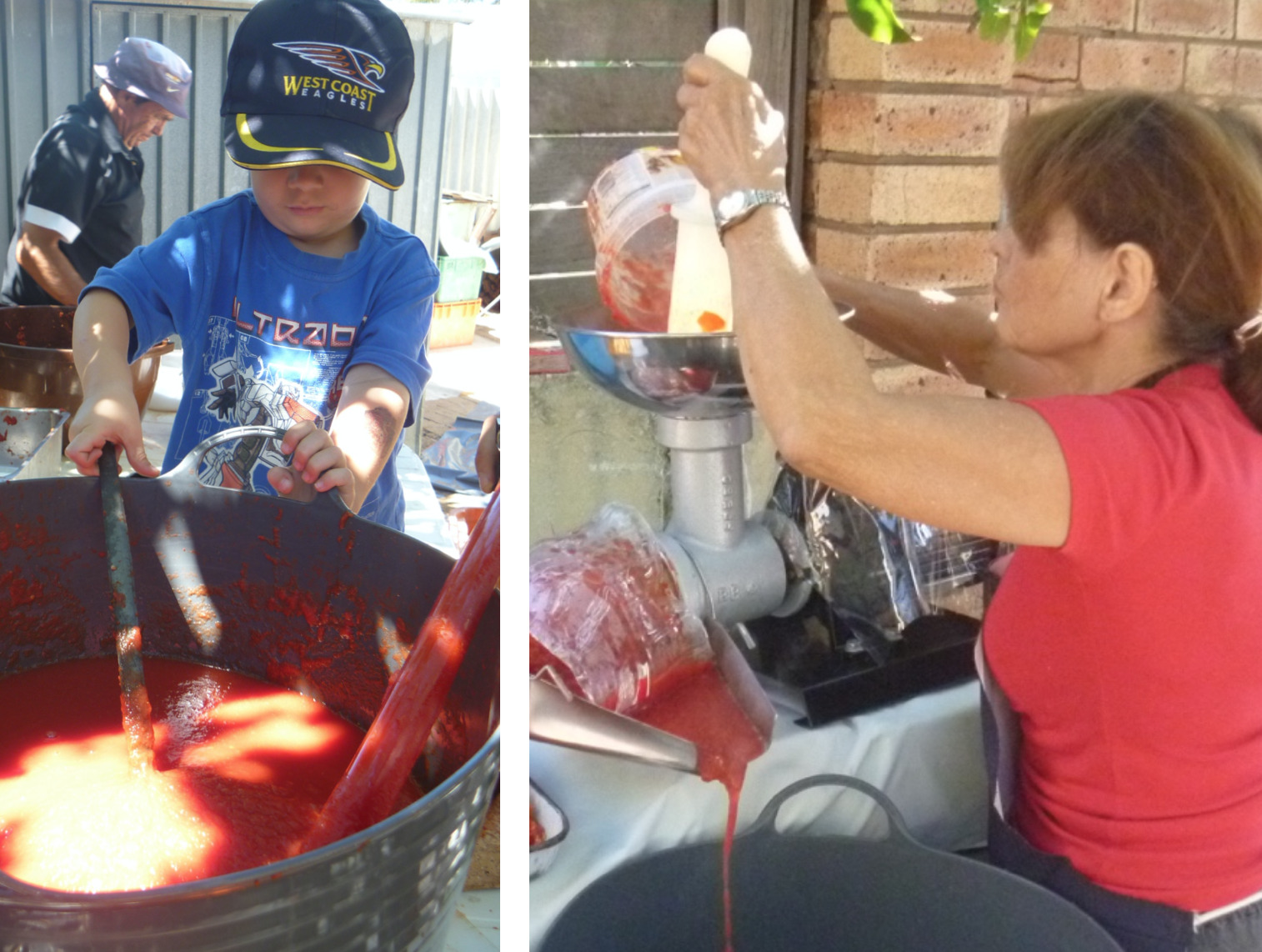
My teenage years and early twenties were filled with processed junk foods: a dizzying array of Hungry Jacks combos, greasy fish and chips, and takeaway meat lovers pizzas.
Cooking was a relaxation practice I stumbled upon much later in life.
Since upping my kitchen game and trading the expensive wellness activities for a sharp knife, solid chopping board, and fresh vegetables, my savings and confidence have grown.
To emerge from the kitchen in a calm and tranquil state, a few conditions have to be in place:
1. You cannot feel rushed
2. Your kitchen counter must be clean and clutter-free
3. You need a sharp knife to chop with
4. Your phone must be out of sight (like most things in life, it’s best not to multitask)
If these conditions are met, cooking can feel like a meditation or an empowering yoga class.
I’m not the only person who feels this way.
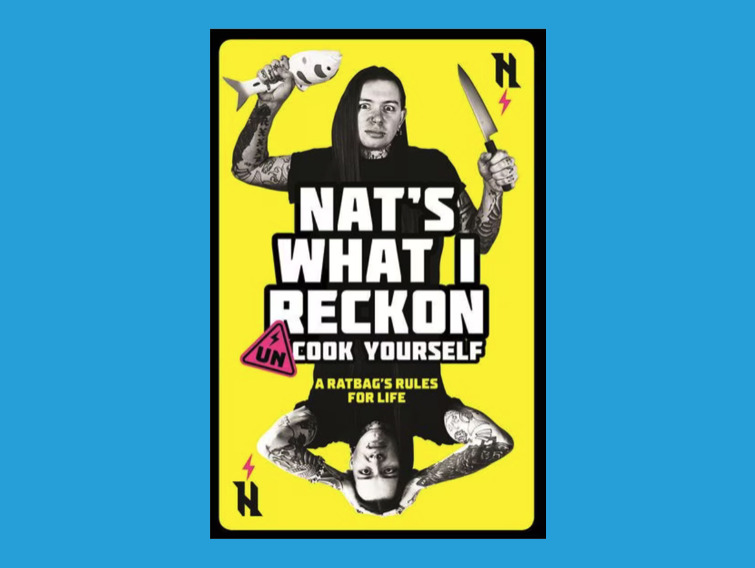
In the book ‘Uncook Yourself: A Ratbag’s Rules for Life’, Nat’s What I Reckon shares how he cooks his way through tough times. He writes:
“I reckon getting in the kitchen and un-cooking yourself from the tough moments in your head every now and then is a way better self-help routine than throwing five grand at some short-lived back pat from a cash grabbing blowhard at a self-help seminar just to tell you you’re not doing life right.”
One reason is you need to focus your mind.
When chopping with a sharp knife, you must pay attention to what you’re doing. If you get distracted, and I have (many times), you might pay the price with a cut to the finger.
Chopping is also a repetitive activity that delivers an immediate outcome. One minute, the bok choy is on the chopping board in full form; the next, it has been chopped and is ready for tonight’s stir-fry.
Cooking also requires you to slow down.
When you’re online, you tend to jump around in a frenzy. But when you’re cooking, you have to follow a recipe step-by-step. This requires focus. This focus helps to clear your mind.
Cooking also gives you a sense of control, power, and agency. As food journalist Michael Pollan says:
“Eating out breeds helplessness, dependence and ignorance, and eventually, it undermines any sense of responsibility.”
When you cook, you’re in control of the process (not some big corporate fast food company). Plus, compared to that commodified wellness experience, cooking is super cheap (all it costs is the price of a few ingredients).
It also produces a nourishing meal at the end. That meal will give you energy, help regulate your mood, and keep you calm and steady.
In the book ‘The Food Mood Connection’, Uma Naidoo argues that to decrease anxiety, you should pay attention to what you’re eating. She writes:
“A crucial part of battling anxiety is making sure your diet is full of foods that are calming and free of foods that put you on edge.”
Fast foods and highly processed foods. These foods (e.g., greasy hot chips and baked goods) are problematic because they lack fibre and the fragile micronutrients and phytochemicals needed for good brain health.
Naidoo recommends increasing your fibre intake by consuming more plants and whole foods, such as beans, brown rice, baked potatoes with the skin on, broccoli, pears, apples, and oats.
A few years ago, I delivered a talk called ‘Rediscovering the Ancient Art of Thrift’ at a local library. In my presentation, I shared the thrifty practice of avoiding eating out and cooking meals at home.
At this point in the presentation, an elderly gentleman put up his hand and said:
“But vegetables are expensive. Why not just get McDonald’s? It’s cheap, and there’s no cleaning up at the end.”
I immediately thought of a friend who, at the time, ate only McDonald’s (for breakfast, lunch, and dinner). His housemates had confided in me that his feet had developed a pungent odour.
Although my diet was far from perfect, I was concerned. If my friend kept going down this path, I could see him heading for serious trouble.
Fast forward a year: How was my friend doing?
He was not well.
He had put on a significant amount of weight and seemed depressed, rarely leaving his room except to get his next McDonald’s meal (back in those days, there was no Uber Eats).

I explained to this elderly gentleman in the library workshop:
“Maybe you’ll save a bit of time and money in the short term [buying the fast food], but eating processed food will cost you down the track. It will cost you in medical bills and poor health. Your quality of life will suffer.”
He nodded, but I could tell he wasn’t entirely convinced.
Until you’ve cut out the processed junk food, allowed a couple of weeks for your tastebuds to readjust, and developed the habit of home cooking, it’s easy to be sceptical. After all, we live in a world that values convenience. Opening an app, pressing a button, and having dinner delivered to your door in less than 20 minutes has some definite appeal.
But every time you order Uber Eats, you miss out on a valuable opportunity to practice slowing down and calming your mind. You also undermine your cooking skills.
If you haven’t developed the habit of cooking or cooking makes you feel anxious, there are a few simple things you can do to cultivate calm and confidence in the kitchen:
Cooking is a messy process. While I may start with a clean kitchen bench, it quickly becomes a mess. That’s how the process goes (I try to clean as I go).
It’s also okay to mess up a meal. Not every meal is going to be an absolute winner. In ‘The Four Hour Chef’, Tim Ferris encourages the reader to see meals that don’t work out as cheap cooking classes. Learn the lesson and move on.
When you think of cooking as one activity, it can feel overwhelming. I divide the cooking process into two stages:
1) Preparing the mise en place: chopping vegetables, taking out utensils, etc, and
2) Pulling it all together: cooking the dish.
In the morning, I take out all the ingredients for a dish so they are ready to go when I need to take a break from my work. I chop earlier in the day and cook the dish in the afternoon/early evening.

If I’m overwhelmed by the idea of chopping vegetables, I break it down to chopping just one vegetable at a time. I’ll say to myself:
“Just chop the capsicum. That’s all you need to do.”
It’s not fun chopping with a knife with a dull blade. A sharp knife combined with a lovely chopping board makes all the difference.
Learning basic chopping skills is a game changer. With the proper technique and a sharp knife, there’s no need to worry about cutting yourself. You can chop with ease.
I took a chopping skills course with the online cooking school Rouxbe, but you can find YouTube videos teaching you good chopping techniques.
You’re not running a restaurant. You don’t have to rush to get meals out to hungry customers. Take your time and enjoy the process of chopping each vegetable.
If approached with the right mindset, cooking can deliver a sense of calm and ground you in the present moment. You also get to experience the mental and physical benefits of a nourishing home-cooked meal. The bonus extra is saving a bit of money.
So, what are you waiting for? Pull out some ingredients and start cooking today.
Share This:
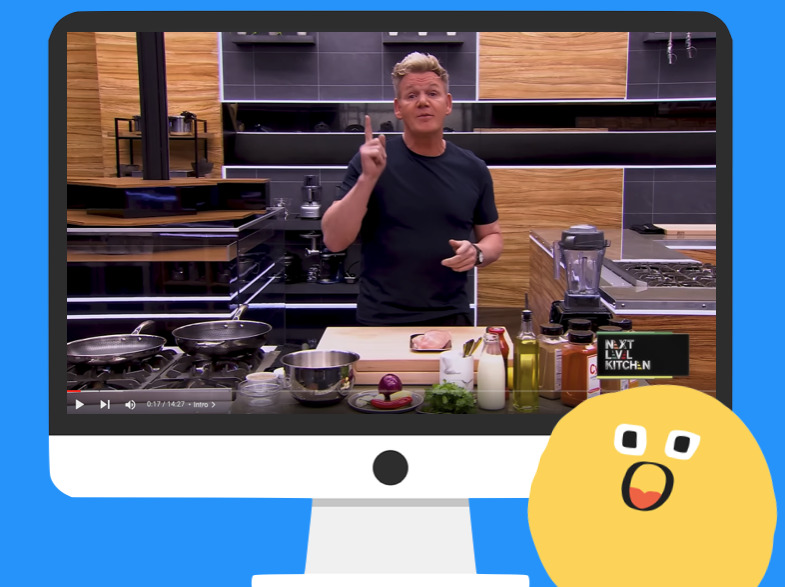
I recently watched a video of Gordan Ramsey cooking a ‘curry in a hurry’ (a butter chicken dish).
I was spellbound by the way Ramsey seamlessly cooked this dish. He was in flow and fully focused on the task of cooking the butter chicken.
What allowed him to whip up this dish plus a serving of rice in under 15 minutes?
Being organised helped a lot. Before he started cooking, chef Ramsey had all the ingredients and cooking utensils out on the bench, ready to go.
In chef’s speak, he had prepared the mise en place.
Mise en place is a culinary skill that can help us to study and work more efficiently. In this article, I explore this concept and how you can apply it to your life to help you stay calm, focused, and in control of your studies.
The mise en place is a French term that translates to “putting in place”. It means a place for everything and everything in its place.
Everything the chef needs is within arm’s reach. When it’s time to start cooking the dish, the chef knows where everything is. This allows the chef to focus on cooking the dish and stay calm and grounded under pressure.

In the book Kitchen Operations (a textbook for hospitality students and apprentice chefs), the authors write about the importance of being organised in the kitchen. They state:
“The ability to work in an organised manner is possibly the most important quality that anyone working in the preparation and service of food can demonstrate. You must develop this ability to complete the expected workload in the time available. Failure to be methodical in your approach will reduce efficiency and will lead to feelings of stress and frustration.”
The mise en place helps the chef avoid unnecessary stress and frustration.
Imagine the following scenario . . .
A chef starts cooking a pasta sauce.
The chef realises 10 minutes in that he is missing a key ingredient (tins of tomatoes).
The chef has to run to the shops to buy the tomatoes.
Chefs can’t afford to have that happen. They are time-pressured. They need to get meals out quickly to hungry customers.
The mise en place helps chefs avoid stressful situations like this. It can also help you decrease unnecessary stress, drama, and frustration associated with homework and study.
Before starting your work, set yourself up with everything you need to complete the task.
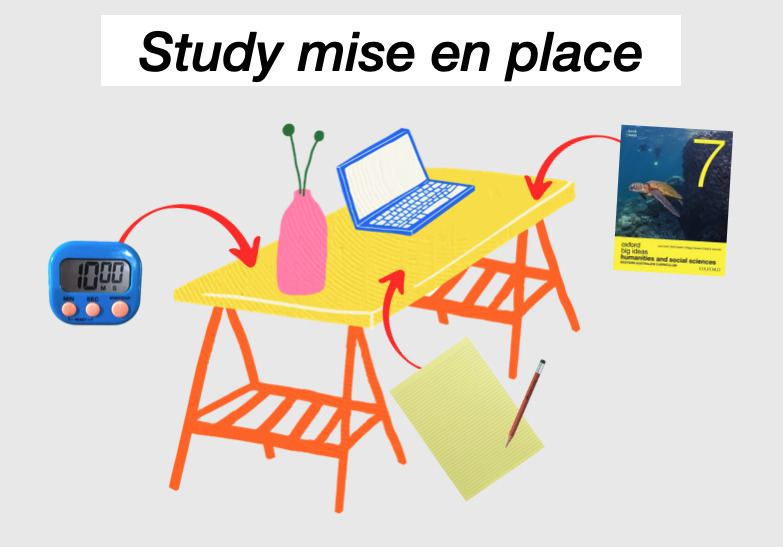
Think of this as the study desk mise en place. Ideally, you want to have a dedicated study space where everything is already set up. This saves you time, as you don’t have to set things up and pack things away after each study session.
But your desk isn’t the only space you can set up and prepare. In the world of study, you have other spaces you need to manage (e.g., a computer, school bag, pencil case, and locker). With each of these spaces, you need to ask:
“What items do I need in this space for my work to flow smoothly?”
It also helps to ask:
“What items don’t I want in this space?”
Just like a chef doesn’t want cockroaches, cats, and rats running around the kitchen and restaurant (or a visit from the local health inspector), there are things you want to keep out of your study space.
Remove anything that throws you off your game (i.e., makes you feel bad, distracted, overwhelmed, and upset) from your study space.
Here’s my list of things I want to keep out of my study space:
• My smartphone
• Long to-do lists
• Visual clutter
The point is to remove any friction points from your environment (anything that will slow you down and make it difficult to do your work).
The mental mise en place cannot be overlooked. This is the mental preparation part of the study process.

Ask yourself:
What must I do to mentally prepare myself for deep work/study?
Most of us can’t just scroll on our social media feed for an hour and launch straight into doing focused study. We need to get into the right headspace.
To be clear, I don’t mean you need to feel motivated, inspired, or in the right mood to study. Too often, we wait for motivation to strike, and it never comes. However, it certainly helps to be calm, focused, and grounded.
My mental preparation for the workday starts the evening before. Too many late nights have taught me that to wake up feeling calm and grounded, I need to go to bed at a reasonable hour.
When I wake up, I protect this mental calm by:
• Going for a walk or lifting heavy weights
• Doing a mini meditation (usually 3-5 minutes)
• Eating a healthy breakfast
• Avoiding checking my email and touching my computer first thing
• Journaling or mind mapping with pen and paper
I stay away from screens for as long as possible. This is essential for cultivating a calm mental state where I feel proactive and in control of my day.
I know I’m in trouble if I skip too many of the things on the list and start the day by checking my email. It becomes much more challenging to focus and get things done.
What is a pest of the mind?
It is anything that overstimulates the mind and leaves one feeling frenzied, scattered, and/or jangled.
Here’s the thing about learning information at a deep level: it requires you to slow down. You cannot rush it, like a 15-minute butter chicken dish.
But we engage with people, places, and things on a daily basis that speed up our thinking. In this overstimulated, wired mental state, learning feels like a hard slog.
Here’s a tip: start to notice the things that leave you feeling overstimulated. It can be incredibly liberating to cut back on these things or eliminate them completely from your life.
I am constantly tweaking my workspace and experimenting with different tools to help me click into a state of flow with my work. Here are some tools that I’m currently enjoying having as part of my study mise en place:
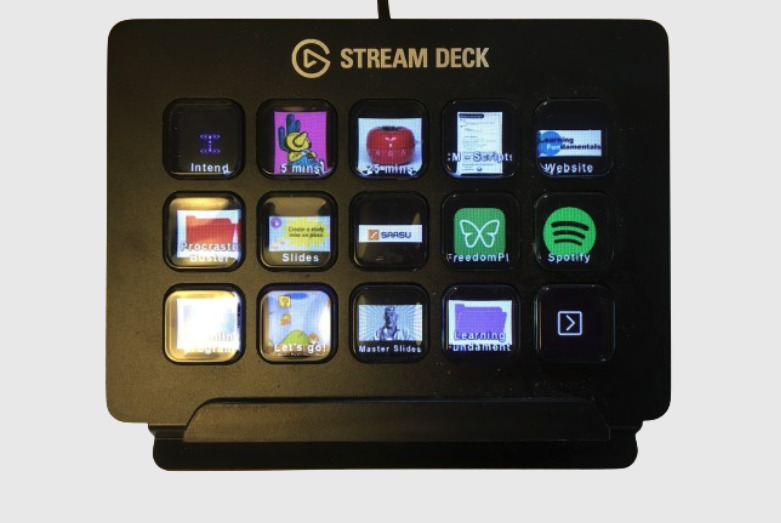
Technically, this is a gaming device that allows gamers who stream to switch scenes, adjust audio, etc at the tap of a button. I’m not a gamer, but I use my Stream deck to get started with various tasks and projects I feel resistance towards.
Instead of thinking, “Where is this file located? How do I get to it?” I tap a button on the Stream deck and it opens the file up. I tap another button, and it opens an application I frequently use.
No more frustrating clicking through numerous folders trying to find the document I need! The Stream deck helps to remove a big mental barrier and kick-start the work process with ease.
Stream decks aren’t cheap but if you can find one secondhand or on special like I did, they are well worth it.
Staying hydrated is super important. I fill a big jug with water every morning and place it on my desk with a glass. If water is within arm’s reach and I can see it, I find myself taking regular sips throughout the day.
I used nasty, cheap pens for years. Being a sucker for free stuff, I collected free pens at career expos and university open days. Without even realising it, these pens caused me a great deal of frustration and irritation.
These days, when it comes to pens, I don’t mess around with junk. There’s one pen I love using: the uniball signo (0.7). It’s a gel pen (you can find them at Officeworks). Writing with this pen is an absolute pleasure.

As Kevin Kelly says:
“Take note if you find yourself wondering “Where is my good knife?” or “Where is my good pen?” That means you have bad ones. Get rid of those.”
It’s super handy to have a notepad to jot down ideas and random thoughts as they arise. I recently discovered Rhodia notepads (a recommendation by The Pen Addict, Brad Dowdy). Writing on this paper feels like writing on butter!

Whenever I notice I’m procrastinating, I’ll set my timer for 10 minutes and say, “All I need to do is 10 minutes on this task. That’s all. Just 10 minutes”. I set the timer and away I go.
Other times, when my workspace looks like a mess, I’ll set a timer for 3 minutes and spend that time getting things back in order.
My planner tells me what to do and when to do it. For the last 6 weeks, I have been experimenting with Cal Newport’s time blocking method (planning my day in hourly blocks). It sounds torturous, but it’s strangely liberating.
When I open my planner, I can see what is happening for the week, but I don’t have a sense of the bigger picture. This is why I printed out a massive (A0 size) year-in-a-glance planner to schedule all my presentations, holiday breaks, special events, etc.
Having this calendar makes me feel more in control of my life. I can see when I have busy periods of presenting and when I need to balance those periods with extra rest time to sustain myself. I can also see events and deadlines relatively to where I am now.
These are just a few things I love having in my study/work mise en place. But we’re all different, so you need to figure out what works best for you.
When I recently asked a group of high school students what items they would need in their study mise en place, here’s what they came up with:
• Snacks
• Phone
• Pencil case
• Squishmallows
The first three suggestions didn’t surprise me, but the squishmallows sure did (the students were shocked that I’d never heard of a squishmallow before). I had to google them (they are soft toys).

But I get it.
A squishmallow is fun.
It’s comforting.
It makes you feel good.
If something makes you feel good, go put it on your desk. Because if you feel good, it will be easier to think and learn.
The mise en place is a skill that can help all of us (not just chefs) focus on the task at hand. The point is you need to make your study mise en place work for you. You need to find the combination of ingredients that hits the spot.
Like a top chef has their favourite chopping knife, you’ll have your favourite pen. Spend some time experimenting with various tools and different work setups. By creating a more streamlined and organised study space, you’ll get that time back. Plus, you’ll find it’s much easier to get going and keep going with your work.

It goes without saying that your brain is the reason you can speak, learn, and think.
With this in mind, your brain is worth protecting from anything that may cause it harm.
There is a growing body of evidence that shows COVID can cause cognitive impairment, even in ‘mild’ cases.
In this blog, I want to share with you some important information and science-based tools that you can use to protect yourself from this novel virus as well as other viruses.
Whilst I’m not a medical doctor, I have a research background. I’m able to access and stay up to date with the latest scientific studies.
I’ve found following the latest research has helped me to move from feeling overwhelmed by the pandemic to empowered. It’s my hope the information in this article will help you feel empowered too.
If you care about learning and cognition, it’s important to understand how COVID can impact the brain.
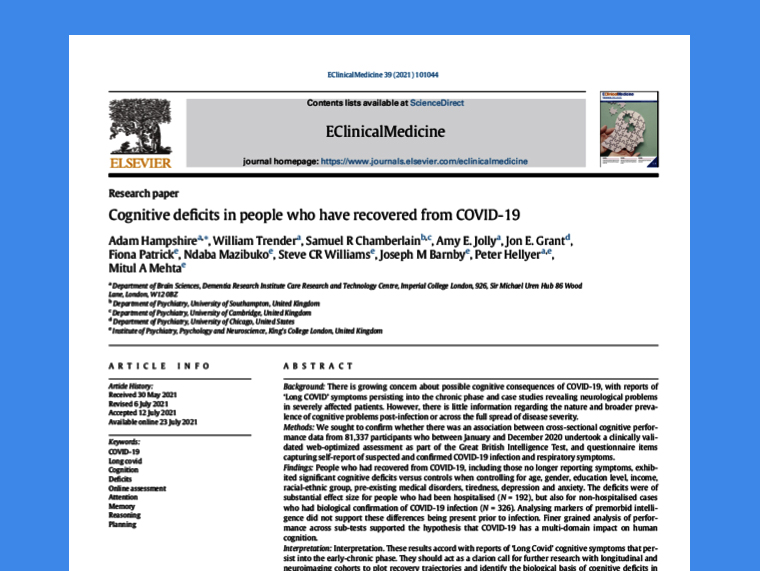
A study published in the Lancet Medical Journal found people who had recovered from COVID experienced cognitive impairments in a range of areas. These areas included executive function (e.g., planning and problem solving), focused attention, memory, and language functions.
The researchers pointed out that these cognitive impairments were found in people who had remained at home with just mild symptoms and did not need to be hospitalised.
Other studies have found being reinfected with COVID increases your risk of getting long COVID. Long COVID can leave you with a cluster of health problems such as brain fog, fatigue, anxiety, depression, chest pain, and loss of taste and smell.
As one long COVID sufferer said:
“You can lose your quality of life and everything that makes you “you” faster than you dreamed possible.”
When COVID first came on the scene back in 2020, public health campaigns focused primarily on encouraging people to wash their hands and socially distance.
But since then, we’ve learnt a lot more about how this virus works. We now know that COVID is an airborne virus. It travels like cigarette smoke and the virus particles can remain in the air for hours.
It can be hard to imagine how a person’s breath (potentially containing virus particles) occupies an indoor space. This is why a group of Aerosol research scientists started an art project called #WeAddAerosols. They created a number of images to help people visualise shared breath in an indoor space (see example below from Dr Amy Tan’s Twitter feed).
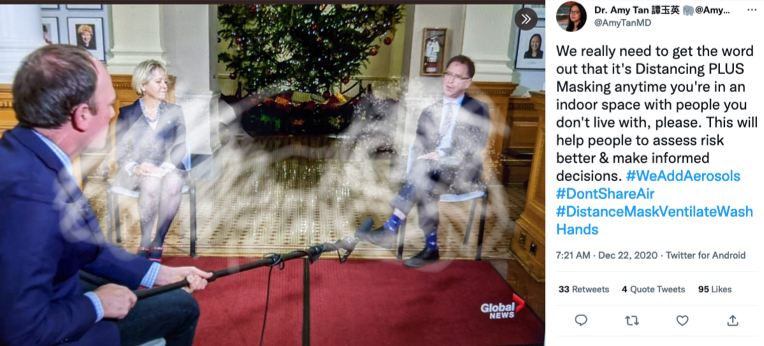
We also now know that vaccinations are not enough on their own. As Professor Quentin Grafton and a team of health experts stated in their excellent submission to the long COVID inquiry in Australia:
“Data show that being fully vaccinated with three (or more) doses in the recent past provides ~90% protection against severe COVID infection, hospitalisation, and death. Data also show from large studies that vaccine protection against long COVID syndrome is substantially lower and much more variable, between 15-66%”
This is why it’s really important to adopt a number of protective measures, especially if your government has weakened public health measures.
A really simple thing you can do is keep an eye on indoor carbon dioxide (CO2) levels.
CO2 is a proxy for indoor air quality.
Dr David Berger at CO2 Radical explains it like this:
“We all breathe in oxygen and breathe out CO2, which means CO2 level in an indoor space increases over time, depending how many people there are in the room and how well it is ventilated.
That means the CO2 level in an indoor space gives an idea of how fresh or stale the air is. If the CO2 level is too high, it means the air is stale and the space needs more ventilation. The more stale the air is, the greater the number of germs, such as coronaviruses, in each breath you take, so the more likely you are to get infected.”
Monitoring CO2 can alert you to COVID risks indoors but it can also prevent sleepiness and poor concentration.
If you’ve ever found yourself falling asleep or struggling to concentrate in a class, meeting, or on long car drive, this may have been due to excessively high CO2 levels.
One study looked at the impact CO2 had on office workers’ cognitive function. The researchers created a simulated office environment and changed the CO2 levels in the office space. They then made the office workers perform various cognitive tasks under the different CO2 conditions.
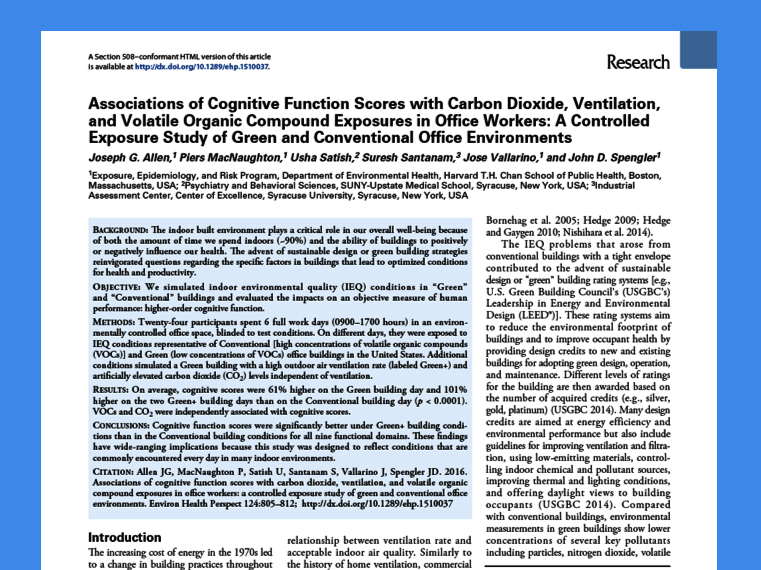
What did they find in this study?
When CO2 levels were higher, people’s cognitive function decreased. But when they opened a window to bring in fresh air (and subsequently, lowered the CO2 level in the office) people’s cognitive function improved.
Some countries already monitor indoor air quality (i.e., CO2 levels). For example, Belgium enforces mandatory CO2 monitors in public places such as restaurants, gyms, and movie theatres. In these venues CO2 levels need to be made visible to the public. Businesses can also receive fines if CO2 is found to be excessively high.
But what if you don’t live in Belgium? What can you do?
You can purchase a CO2 monitor. These nifty, portable little devices will measure CO2 concentrations for you.
Seeing is believing. The numbers will alert you to potentially dangerous situations. You can then decide to either open a window and/or doors or leave the building.
The chart below will help you make sense of the numbers.
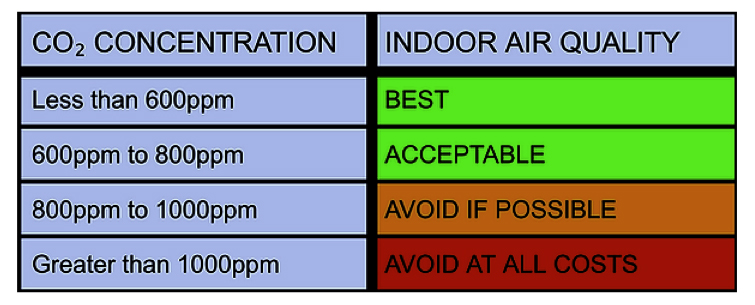
If the reading is below 700ppm, this means the room has less than 1% of people’s air. At 500ppm, you are down to only 0.2% of people’s air.
But when CO2 gets to 3000ppm or higher (which has been found in some classrooms), 9-10% of each breath you take was recently exhaled by someone else. As Dr Berger states:
“It’s like drinking water that’s just been swirled round someone else’s mouth.”
There are different CO2 monitors on the market that vary in price and quality.
First up, there is the Aranet4.
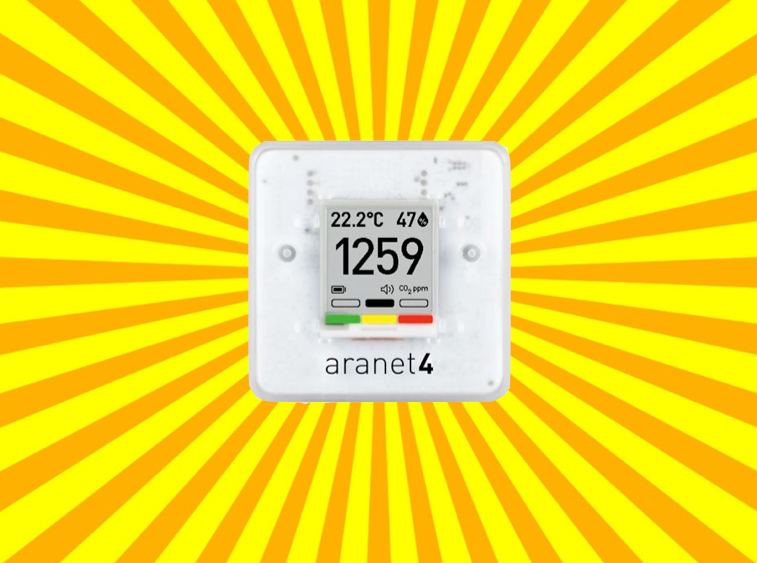
This is considered the gold standard as far as CO2 monitors go. The Aranet comes with an app that allows you to program the device to beep and alert you if CO2 goes above 1400ppm. But this device is not cheap (I paid $380AUD for mine).
How could I justify spending this kind of money?
It was easy. I figured this device could stop me from getting really sick. And if I get sick, I can’t work or do any of the things I really enjoy. It was a no-brainer.
Before you race off and buy an Aranet, there is a much cheaper option I only just recently discovered: The mini carbon dioxide monitor supplied by Theatre Caps.
This CO2 monitor retails for just $80AUD (that’s a whopping saving of $300AUD).
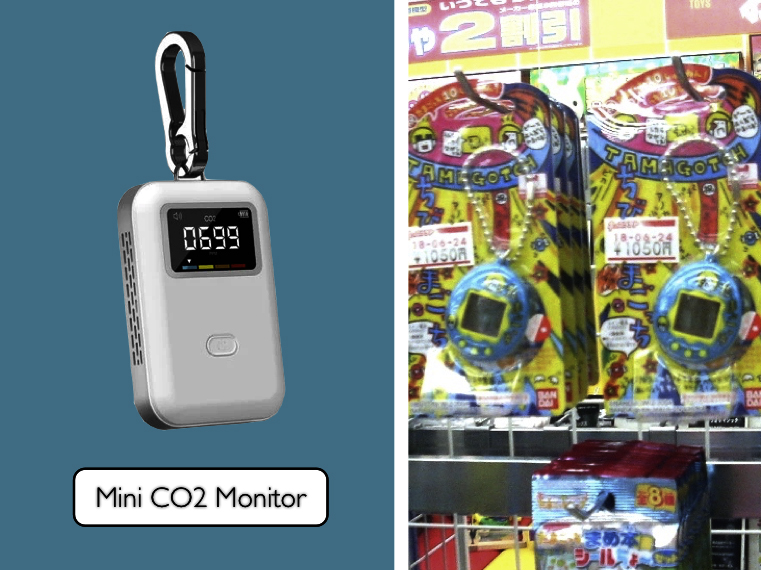
This device reminds me of a Tamagotchi (i.e., a digital pet). It’s small, portable, and can be attached to your keys.
Mask up.

Wearing a mask is one of the most effective ways to avoid getting COVID and long COVID.
Personally, I love wearing a mask when I go out. Not only does it provide an extra layer of protection but it makes me feel like a scientist.
Some masks are better than others. I use a well fitted KN95 mask (3M Aura 9320A+). According to research, these offer the best protection due to their tight seal. I’ve been told by doctors I can use these masks multiple times until the seal becomes loose or the bands snap.
Unfortunately, cloth masks don’t cut it. I realise this isn’t good news for the environment. But in order to be able to protect the environment, you need to protect yourself first.

Another thing you can do is organise social gatherings outdoors. As I write this, my husband is catching up with two of his friends outside on our back verandah.
If you’re going to socialise indoors, here are a few things to consider:
• Use a HEPA air filter
• Limit the duration of the gathering
• Limit the number of people at your gathering (the bigger the crowd, the greater the risk)
• Wear KN95 masks
• Open windows and doors for increased air flow
This idea of ‘living with COVID’ shouldn’t mean ignoring it. It should mean adopting protective measures to avoid infection and reinfection.
The science is clear: there are a number of simple and effective things you can do to protect yourself. Why not become a citizen scientist by investing in your own CO2 monitor and a well fitted KN95? It will be money well spent.
Image Credit: “Tamagotchi” by LonelyBob is licensed under CC BY-NC-SA 2.0.
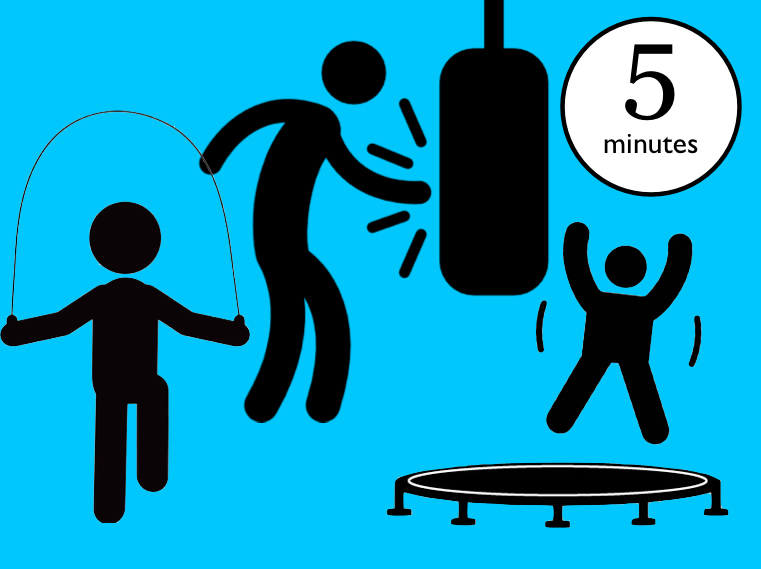
Here’s a simple thing you can do to help you focus better and improve your study sessions . . .
Take regular exercise breaks.
A study titled Sweat so you don’t forget found that engaging in regular five minute exercise breaks reduced mind wandering, improved focus, and enhanced learning.
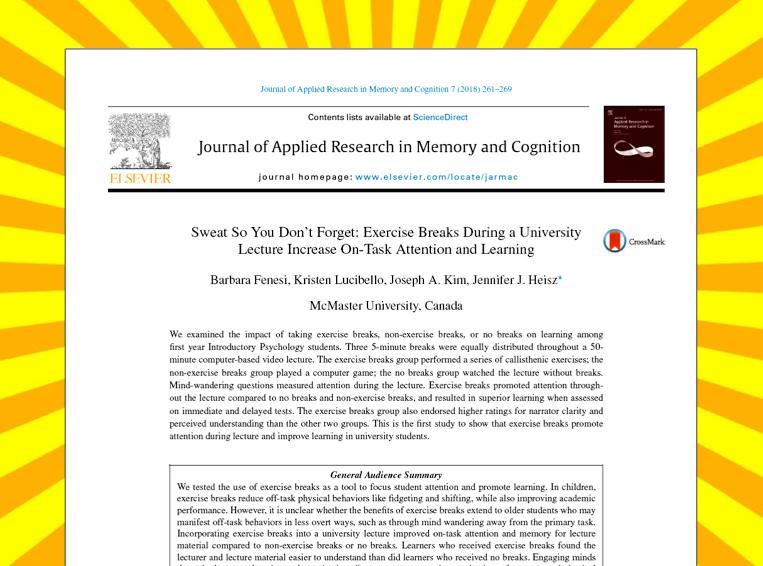
In this study the researchers wanted to know if engaging in short exercise breaks could help with learning.
They took a group of 75 psychology students and split them into three groups.
Group 1: Exercise breaks group
Group 2: Non-exercise breaks group
Group 3: No breaks group

All the students had to watch the same 50 minute psychology lecture. But the difference between the groups was this . . .
The exercise breaks group performed five minutes of exercise every 17 minutes. The non-exercise breaks group played a simple video game for five minutes every 17 minutes. The no breaks group had to watch the entire lecture without getting a single break.
The students in the exercise breaks group could focus better and they retained more information. They also found the lecturer easier to understand.
The researchers said:
“The exercise breaks buffered against declines in attention resulting in superior engagement during the latter part of the lecture compared to the other two groups.”
One would think they would show some improvements in attention and memory since they were getting breaks. But they didn’t show any significant improvements.
In fact, they performed just as well as the no breaks group in terms of attention and memory.
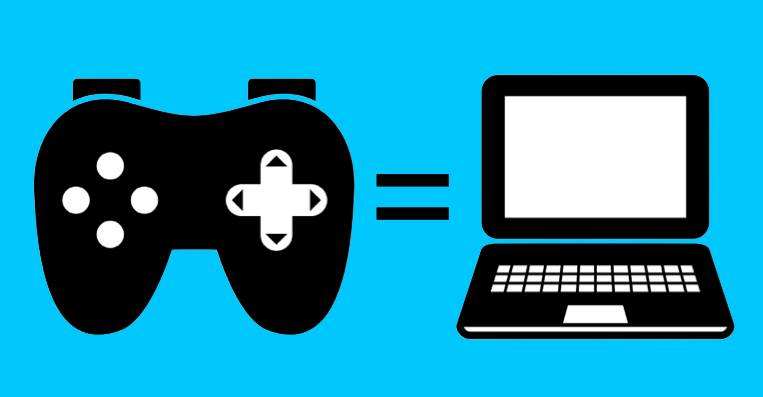
The researchers concluded:
“One possibility is that the computer game played during the non-exercise break may have acted as a second cognitive task as opposed to a cognitive break. Switching between two cognitive tasks can deplete attention and impair performance for both tasks.”
This shows the type of activity you engage in on a study break is really important. It pays to get out of your head and move your body!
It was a series of exercises performed for 50 seconds each followed by a rest break:
1) Jumping jacks (50 seconds) + Rest (10 seconds)
2) Heeltaps (50 seconds) + Rest (10 seconds)
3) High knees (50 seconds) + Rest (10 seconds)
4) Split jumps (50 seconds) + Rest (10 seconds)
5) Hamstring kickers (50 seconds) = The End
Since reading this study, I’ve started to incorporate more exercise breaks into my day and I’m noticing a big difference.
Personally, I’m not a fan of some of the exercises the researchers made the participants do in this study. So, I have replaced them with other cardio exercises I enjoy doing, such as punching a boxing bag and using a skipping rope.
I also find doing 50 seconds of non stop exercise pretty exhausting. For this reason, I’ve reduced my exercise time down to 40 seconds followed by a 20 second rest break. I find it helps to time my exercise sprints/rest breaks using an interval timer on my phone instead of a kitchen timer (which can feel a little clunky).
Feel free to experiment with different exercise/rest ratios. Make it work for you. As your fitness levels improve, you can increase the period of time you exercise for.
After working for 20 or 30 minutes, get up and take a five minute exercise break.
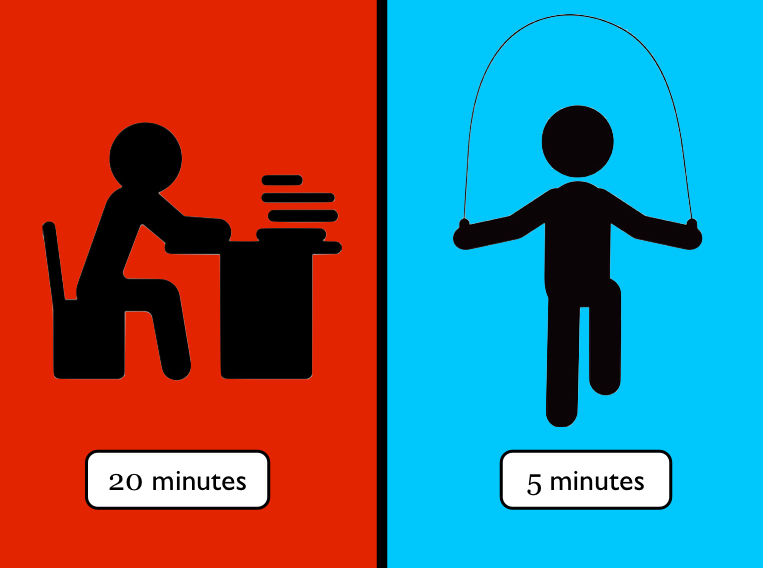
You don’t have to do jumping jacks or hamstring kickers. Select simple exercises you want to do.
Notice how you feel before and after your exercise break.
After experimenting with this simple strategy, I can say with confidence that I feel more energised and mentally sharper throughout the day. Try it and let me know how you go!
Dr Jane Genovese delivers interactive sessions on learning to learn, combating procrastination, exam preparation, how to focus in the age of distraction, habit formation and much, much more!
Get FREE study and life strategies by signing up to our newsletter:
© 2024 Learning Fundamentals